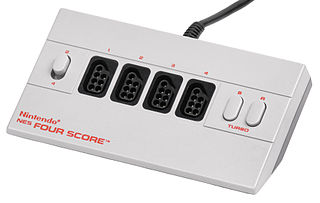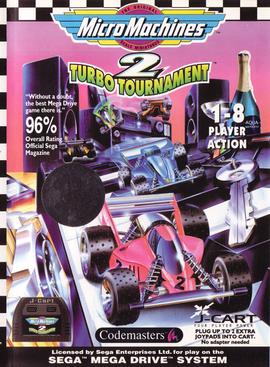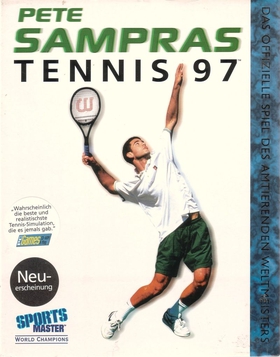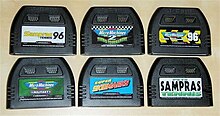
Petros "Pete" Sampras is an American former world No. 1 tennis player. Sampras is regarded as one of the greatest tennis players of all time. His professional career began in 1988 and ended at the 2002 US Open, which he won, defeating his longtime rival Andre Agassi in the final. Sampras won 14 major singles titles during his career, which was an all-time record at the time of his retirement: a then-record seven Wimbledon titles, two Australian Opens and a joint Open Era record five US Open titles. He won 64 singles titles in total. He first reached the world No. 1 ranking in 1993, and held that position for a total of 286 weeks, including an Open Era record of six consecutive Year-End No. 1 rankings from 1993 to 1998. A right-handed player with a single-handed backhand, his precise and powerful serve earned him the nickname "Pistol Pete". In 2007, he was inducted into the International Tennis Hall of Fame.

A gamepad is a type of video game controller held in two hands, where the fingers are used to provide input. They are typically the main input device for video game consoles.

The NES Four Score is a multitap accessory created by Nintendo in 1990 for the Nintendo Entertainment System. Select games can utilize it to enable up to four-player gameplay. The NES Four Score is similar to the previously introduced NES Satellite, a device that allows four players to connect to the NES and extends the range using infrared wireless communication.
A famiclone is any clone console of the Nintendo Entertainment System (NES), known in Japan as the Family Computer or Famicom. They are electronic hardware devices designed to replicate the workings of, and play games designed for, the NES and Famicom. Hundreds of unauthorized clones and unlicensed copies have been made available since the height of the NES popularity in the late 1980s. The technology employed in such clones has evolved over the years: while the earliest clones feature a printed circuit board containing custom or third party integrated circuits (ICs), more recent (post-1996) clones utilize single-chip designs, with a custom ASIC which simulates the functionality of the original hardware, and often includes one or more on-board games. Most devices originate in China and Taiwan, and less commonly South Korea.

The Codemasters Software Company Limited is a British video game developer based in Southam, England, which is a subsidiary of American corporation Electronic Arts. Founded by brothers Richard and David Darling in October 1986, Codemasters is one of the oldest British game studios, and in 2005 was named the best independent video game developer by magazine Develop.

Pete Sampras Tennis is a sports video game, developed by Zeppelin Games and published by Codemasters. It was followed by Sampras Tennis 96 for Sega's 16-bit console and later by Pete Sampras Tennis '97, released for the PlayStation and Windows/DOS.
A multitap is a video game console peripheral that increases the number of controller ports available to the player, allowing additional controllers to be used in play, similar to a USB hub or a power strip. A multitap often takes the form of a box with three or more controller ports which is then connected to a controller port on the console itself.

The Commodore 64 Games System is the cartridge-based home video game console version of the popular Commodore 64 home computer. It was released in December 1990 by Commodore into a booming console market dominated by Nintendo and Sega. It was only released in Europe and was a considerable commercial failure. The C64GS came bundled with a cartridge containing four games: Fiendish Freddy's Big Top O'Fun, International Soccer, Flimbo's Quest, and Klax.
The Gamegun is the only light gun released for the 3DO Interactive Multiplayer video game console. It was released in 1994 by American Laser Games, developers of full motion video-based shooter games. The Gamegun is styled exactly like the Peacekeeper Revolver, except with a notable color difference. The peripheral came in two versions: one player and two-player. The only difference between the two is that the two-player version, which was released in 1995, came with an attached y-connector end, allowing two players to plug in two light guns to play simultaneously. With the one player version, the gun could be daisy chained with a regular 3DO controller, allowing another player to use the gamepad at the same time.

Pro Tennis: World Court is a tennis sports video game that was released by Namco in 1988 for Japanese arcades. It runs upon Namco System 1 hardware, and was inspired by the 1987 Famicom game Family Tennis. In August 1988, the game was ported to the PC Engine console, in which a new tennis-based role-playing quest mode was added, and was later ported to the North American TurboGrafx-16 console by NEC under the title of World Court Tennis in 1989. Up to four players could play simultaneously. A sequel named Super World Court was released in 1992, which ran on Namco NA-1 hardware and allowed up to four players to play simultaneously. The arcade version was recently confirmed to be released on the PlayStation 4 and Nintendo Switch as part of the Arcade Archives lineup on May 12, 2022 worldwide.

Sampras Tennis 96 is a 1995 tennis video game for the Sega Genesis developed by Codemasters. It is the sequel to Pete Sampras Tennis. Like its predecessor, it was one of the few titles released on the J-Cart format, which provides two additional controller ports for multiplayer games. The game was followed by Pete Sampras Tennis '97, which was released for the PlayStation and personal computers.
Micro Machines is a series of video games featuring toy cars, developed by Codemasters and published on multiple platforms. The series is based on the Micro Machines toy line of miniature vehicles.

Rafa Nadal Tennis is a tennis video game, developed by VirtualToys and published by Codemasters. It was released for the Nintendo DS in January 2007 and on the Wii December 27. The game features tennis athlete Rafael Nadal on the cover and primarily focuses around the sport of tennis.

A ROM cartridge, usually referred to in context simply as a cartridge, cart, or card, is a replaceable part designed to be connected to a consumer electronics device such as a home computer, video game console or, to a lesser extent, electronic musical instruments.

Pegasus is a clone of the Nintendo Famicom that was sold in the Czech Republic, Poland, Indonesia, Bosnia-Herzegovina and the Federal Republic of Yugoslavia during the early to mid 1990s.

Micro Machines V3 is a racing video game developed by Codemasters and Novalicious for PlayStation, Microsoft Windows, Nintendo 64, and Game Boy Color.

Micro Machines 2: Turbo Tournament is a 1994 racing video game developed by Supersonic Software and published by Codemasters for the Sega Mega Drive. The sequel to Micro Machines, the game is themed around Galoob's Micro Machines toys, and players race around environments in miniature toy vehicles. Micro Machines 2: Turbo Tournament adds new vehicles and game modes, and the Mega Drive version was released on J-Cart, enabling up to eight players without a multitap.

The PlayStation Multitap is a peripheral for the PlayStation. It is an adapter that can be used to plug in up to four controllers and memory cards at the same time in a single controller port. With a second multitap, up to eight controllers and memory cards can be plugged at once.

Pete Sampras Tennis '97 is a tennis video game developed and published by Codemasters. It was released for Microsoft Windows and MS-DOS. It was also released for the PlayStation as Sampras Extreme Tennis. It was endorsed by multiple Grand Slam champion Pete Sampras who appears in the game as an unlockable character. It is the third and final game in the Pete Sampras Tennis series, following Pete Sampras Tennis and Sampras Tennis 96.

Micro Machines is a racing game developed by Codemasters and originally published by Camerica for the Nintendo Entertainment System in 1991. Themed around Galoob's Micro Machines toys, players race in miniaturised toy vehicles around various environments. The game is the first installment in the Micro Machines video game series.

















